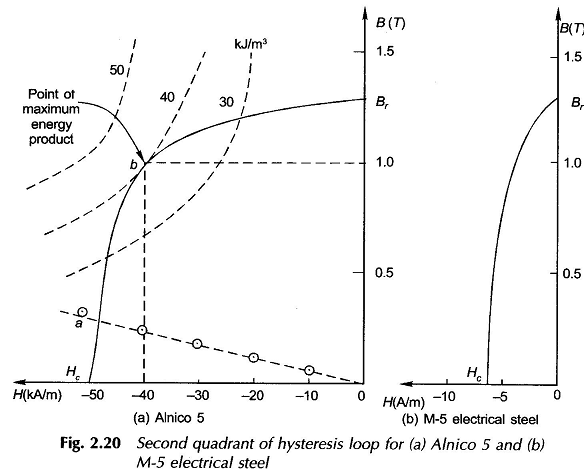Define Permanent Magnet in Magnetic Circuits:
Define of Permanent Magnet is an important excitation source (life long) commonly employed for imparting energy to magnetic circuits used in rotating machines and other types of electromechanical devices.
There are three classes of permanent magnet materials (or hard magnetic materials) used for permanent magnet dc (PMDC) motors: Alnicos, ceramics (ferrites) and rare-earth materials. Alnico magnets are used in motors up to 200 kW, while ceramic magnets are most economical in fractional kW motors. The rare-earth magnetic materials are very costly, but are the most economic choice in very small motors. Latest addition is neodymium-iron boron (Nd FeB). At room temperature, it has the highest energy product (to be explained later in this section) of all commonly available magnets. The high permeance and coercivity allow marked reductions in motor frame size for the same output compared to motors using ferrite (ceramic) magnets. For very high temperature applications Alnico or rare-earth cobalt magnets must be used.
Two important qualities of a Define of Permanent Magnet in Magnetic Circuits are defined below with reference to the second quadrant of its hysteresis loop.
Permanent magnetization or residual flux density (Br):
It is the flux density trapped in closed magnetic structure if the applied mmf (and therefore the magnetic field intensity, H) were reduced to zero.
Coercivity:
It is the measure of mmf (or H) which, when applied to the magnetic circuit, would reduce its flux density to zero, i.e. it would demagnetize the material. Its value is negative and in units of kA/m.
The second quadrant of the hysteresis loops for Alnico 5 and M-5 steel are shown respectively in Figs. 2.20(a) and (b). Their residual flux densities and coercivities are given below:
It is therefore observed that while Br of M-5 steel is higher than that of Alnico 5 but the latter (Alnico 5) has a far greater coercivity. As we shall see below that materials with high coercivity qualify as PM materials.
An important measure of the capability of permanent magnet is known as its maximum energy product. This corresponds to the largest BH product, (BH)max, which
is a point on the second quadrant of the hysteresis loop; see Fig. 2.20(a). It has the dimensions of energy density (J/m3) and it can be shown that operation of a given PM material at this point will result in the minimum volume of material required to produce a given flux density in the air gap.
